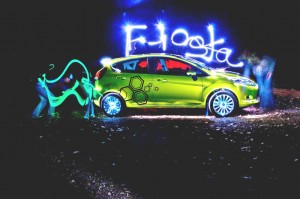
Ford hopes to target an expanding small car market with the 2011 Ford Fiesta, but a new study says the market may be smaller than some makers have hoped.
This month’s Los Angeles Motor Show brought the launch of an assortment of small cars, including Ford’s new Fiesta and Mazda’s subcompact Mazda2. Even more downsized offerings will make their debut at Detroit’s North American International Auto Show, next month.
Borrowing a maxim from the film, “Field of Dreams,” manufacturers are betting that if they build ‘em, customers will come, especially in an era of costly fuel and new government mileage standards. But a new study warns that even with an array of attractive new offerings, American car buyers may not be ready to accept small as beautiful.
“Our research shows that, despite what the U.S. Government is telling us, few Americans want to downsize to smaller cars,” says George Peterson, President of the Los Angeles-based consulting firm, AutoPacific, “Finding more buyers inclined to purchase smaller cars will not be easy.”
Exactly how much of the market today is made up by small cars, trucks and crossovers depends on who you ask and how they parse their data. Ford claims the segment has grown from around 14% in 2004 to nearly 22% in 2008. But other data show that small car demand has been slipping, again, since fuel prices hit their peak, in July of last year.
Including those American motorists now in the market who even say they might consider a small car, AutoPacific says that adds up to just 25%, “and many of those won’t actually wind up buying a small car,” says AutoPacific analyst Stephanie Brinley.
She cautions that, “Americans just aren’t in love with small cars. They’re seen as econoboxes and not as safe as larger vehicles.” And U.S. motorists like the space to carry “stuff,” something that can be difficult with a smaller vehicle.
Fuel prices certainly can shift the market, history shows, but not as dramatically as conventional wisdom might suggest. Research by Experian Automotive showed that while demand for big trucks plunged, and for small cars rose, during last year’s fuel price run-up, buying patterns started to return to normal even before prices peaked.
But the industry is in a position where it may have to nudge consumers to shift their behavior, what with the federal government now mandating an increase to a Corporate Average Fuel Economy, or CAFE, standard of 35.5 mpg by the middle of the coming decade.
Getting there will all but certainly require downsizing, according to most industry leaders. But Brinley warns that message is lost on the typical motorist. “People want technology to solve the problem of fuel economy.”
That’s not entirely out of the question. Makers hope to achieve significant mileage gains by adopting lighterweight materials and new powertrain technologies, such as diesels, hybrids and advanced gasoline systems – such as the Ford EcoBoost powertrain. But few observers believe that will be enough to comply with the new CAFE rules.
The challenge, says Brinley, is to appeal to various buyer groups, such as one AutoPacific dubs the “Affluent Progressives,” that are more open to shifting their purchase patterns.
There are some signs that this can work. The British-made Mini has attracted a core of buyers that would normally never have opted for a small car before. Ford is hoping to win over less affluent buyers with Fiesta by delivering a mix of style, performance and features not normally found in a small car, along with the high mileage and low price that are normally the hallmarks of stripped-down econoboxes.
(Click Here for a First Look at the 2011 Ford Fiesta.)
Whether that is enough to shift the market remains to be seen, but the latest research suggests it will be a tough sell.

People will buy small cars because they will not be given a choice. I expect that when backed to the wall, automakers will use the price mechanism to ensure that people buy small cars–small cars will be discounted, offset by high profit margins on guzzlers. The days of the affordable V8 will be over.